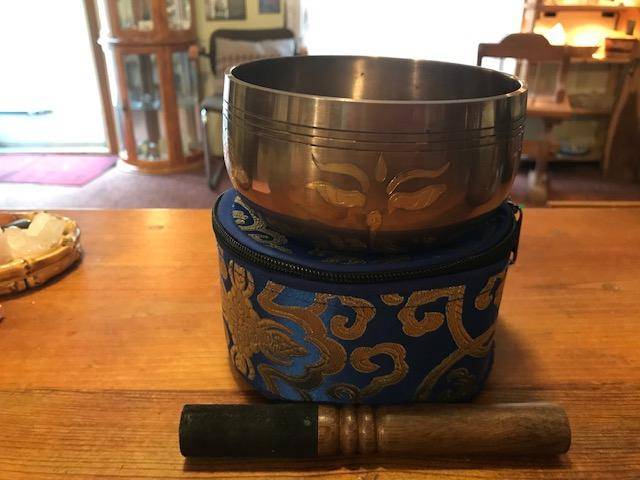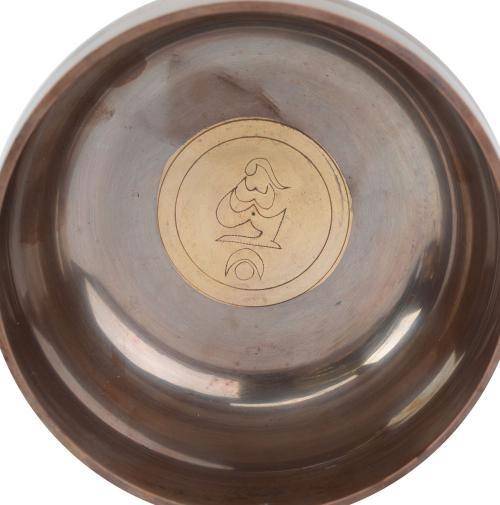5 inch OM Copper Alloy Singing Bowl with Brocade Case
Easy Play OM Copper Alloy Singing Bowl with Silk Brocade Case and playing stick and playing instructions – 5 inch diameter by 2.5 inches tall
$122.00
Guide to Playing Himalayan (metal) Singing Bowls
The sound resonating from these singing bowls is pure and very powerful in centering the mind and body. Unlike the man-made, molded quartz crystal bowls, these are entirely hand-made. These bowls may be several generations old. They come complete with a wooden striker stick.
HISTORY
Traditional bowls are made in ceremony, of seven metals: one metal for each of the planets. ( Gold-the Sun, silver-the Moon, Mercury-Mercury Copper-Venus, Iron- Mars, Lead-Saturn, Tin-Jupiter
It is believed that either wondering nomads made the bowls or they were made within the Tibetan monasteries themselves. Since the Chinese invasion of Tibet, the traditional bowl makers all but disappeared.
Modern bowls are usually made from 3-5 metals and molded or lathed and hand hammered.
SOUND OF THE BOWLS
It has been found that among the wave patterns of different singing bowls there is a measurable wave pattern which is equivalent to the alpha waves produced by the brain. These bowls instill a sense of deep relaxation and “inner space opening up”
HOW TO PLAY YOUR METAL SINGING BOWL
Producing the most harmonious tones requires balancing three factors: the pressure of the mallet against the rim of the bowl (firm), the mallet angle (almost perpendicular to the bowl), and the speed (not too fast).
1. Rest the bowl on the palm of your hand or balance it on your fingertips.
2. With the other hand, grasp the mallet in the middle, with fingertips and palm pointing downward.
3. To “ready the bowl”, gently tap the mallet against the side of the bowl. Now, with firm, even pressure, rub the mallet clockwise around the outside edge of the rim of the bowl. Keep the mallet straight up and down, lock your wrist and use a full arm motion, as if stirring a large kettle of soup. Apply firm pressure, as the friction of the mallet against the outer rim produces the vibrations that result in sound.
Allow the sound to build up slowly. If a rattling or buzzing sound occurs, adjust your speed (slower) and your pressure (firmer) against the rim. Be patient! Learning to play the bowl to its fullest is a meditation in itself!
Note: Some strikers have one end wrapped in leather to create a deeper sound. Use the wood end for light, clear tones, the leather end for deeper tones.
WHAT TO EXPECT
Singing bowls have three sets of double tones, very rich in harmonics and micro-tones. A dominant base or male tone, a dominant treble or female tone, and interval dominant consisting of the blending of the base and treble.
Experiment with your playing technique until, with time and patience, all tones may be sensed or heard.
With practice, the sound of your bowl will be sustained from 30 seconds up to 2 or 3 minutes after you stop playing.
You may even find that after playing the bowl for awhile, hours or even days later, walking down the street or reading the paper, you hear the bowl singing in your ears.
This is quite natural and signals a very enhanced state of awareness.
PRACTICE WITH YOUR BOWL
Anyone who owns his or her own singing bowl has access to a magic land of great variety. There is much to discover, to experiment with, to hear and to experience in the bowl and your inner self.
Strike or rub the bowl and
- LISTEN to the sounds and tonal qualities,
- FEEL the vibrations at different body points,
- OBSERVE the vibrations (filling the bowl with water may assist observation)
- SENSE what is occurring in body, mind, and spirit
Related products
-
Theta Tuning Wind Chimes
Theta Chimes — 8 Tones of the Enlighten Tuning
$72.00 Read moreRelax into Enlightenment & listen to the music of the Theta Chime Enlighten. Hear the melody of the notes E G B E G# B D E when the wind blows. Weight: 142 grams Chime size: 7 inches tall x 2.5 inches wide. Scroll down to listen to the chimes!
Rated 0 out of 5 -
Singing Bowls
600 gram Decorated Singing Bowl
$195.00 Add to cartThe perfect small bowl to carry with you for meditations and ceremonies. 600 gram Decorated Singing Bowl – 5 inch diameter by 3 inch height – Singing Bowl with playing stick & instructions
Rated 0 out of 5 -
Singing Bowls
505 gram Singing Bowl
$151.00 Add to cartThe 505 gram weight bowl on the right has a 5 inch diameter and 3 inch high sides. Bowl-playing stick-instructions
Rated 0 out of 5 -
Singing Bowls
Ashtamangala 3-metal Carved Singing Bowls
$56.00 Read moreOne Singing Bowl, approx. 350 gram Singing Bowl-playing stick-instructions
Rated 0 out of 5






